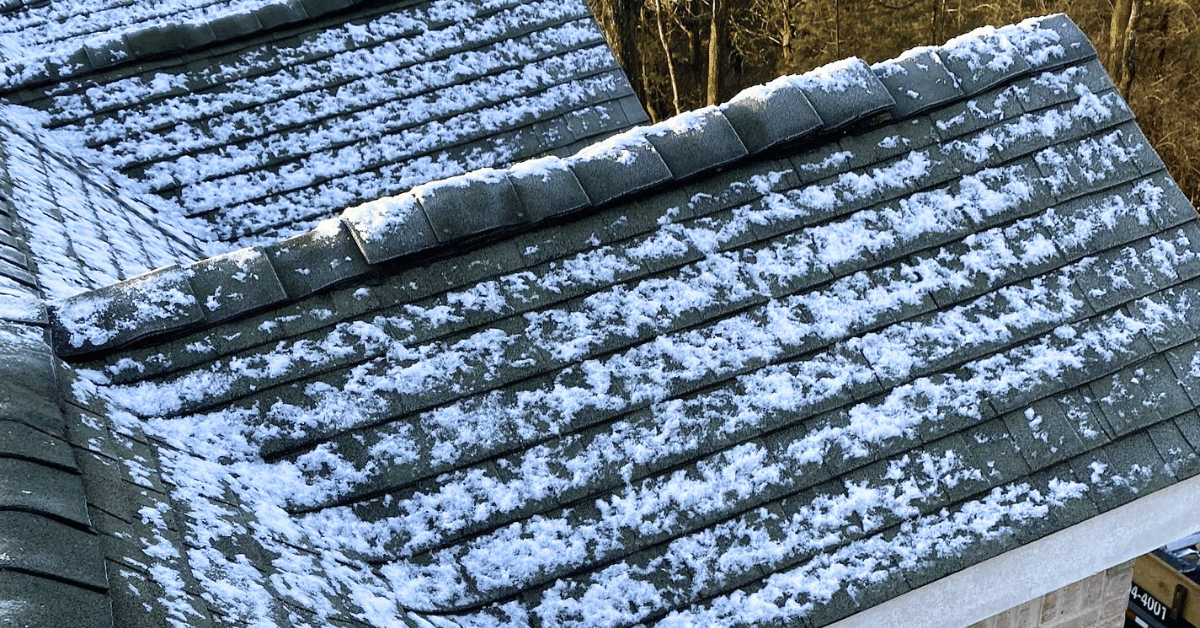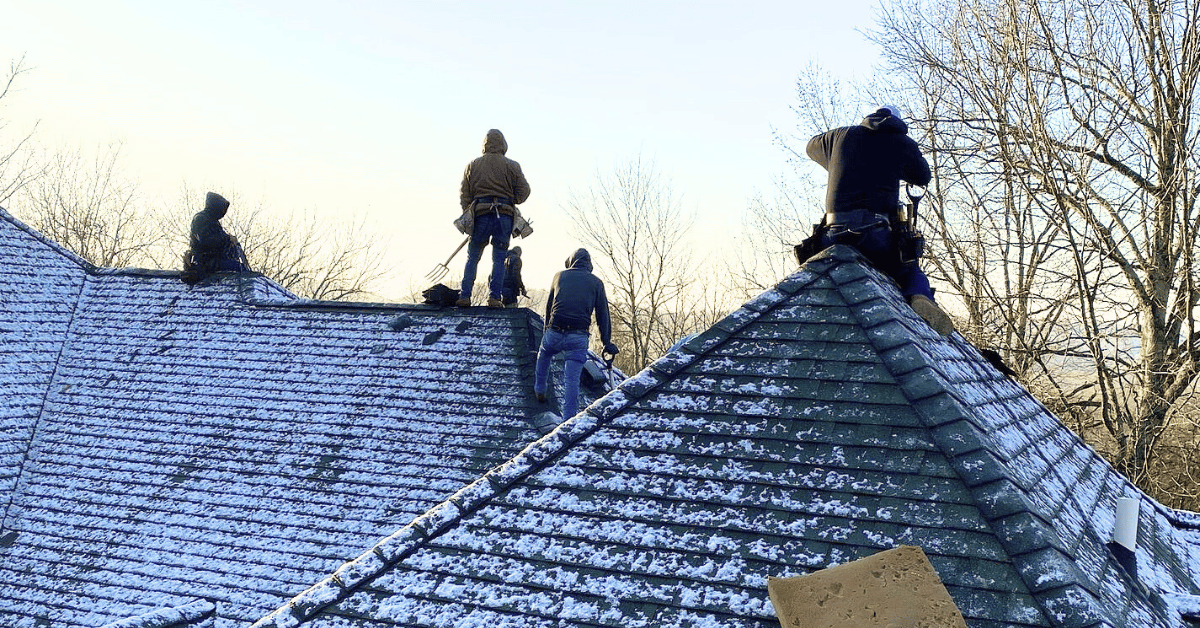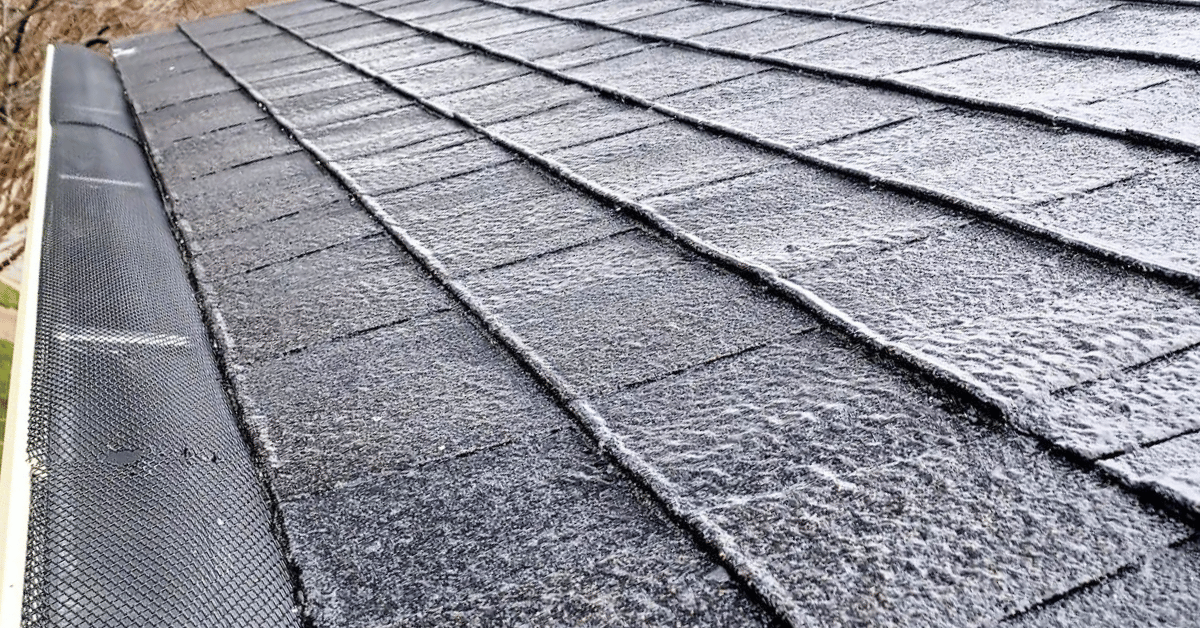
Highlights for Winter Roofing
Winter roofing brings unique challenges but remains crucial for homeowners needing immediate repairs or replacements. With careful planning, appropriate materials, and adherence to safety precautions, a qualified roofing contractor can overcome cold-weather obstacles. This article explores cold-weather installation techniques, proper materials, and Nashville-specific winter considerations to ensure safe and effective winter roofing.
Table of Contents
Winter Roofing: How to Roof When It’s Cold
Winter roofing may not be ideal, but it’s often essential for homeowners in colder climates, including Nashville and Middle Tennessee. The fluctuating temperatures in this region create specific challenges for roofing contractors and homeowners alike. Many customers question if installing a roof in winter is safe, especially with frequent shifts from freezing temperatures to unseasonably warm days.
While most materials are easier to work with in warmer weather, roofing during winter can be achieved with suitable materials and strategies. Optimal weather conditions for installing asphalt shingles are temperate, ensuring flexibility and a proper waterproof seal. Roofing contractors who understand the intricacies of cold-weather roofing can safely install asphalt shingles, even when the weather doesn’t cooperate. However, winter installations risk shingles becoming brittle and breaking, which can lead to potential water damage if not addressed. This article covers essential strategies and materials to ensure that cold-weather roofing projects are completed safely and effectively, meeting the urgent needs of Middle Tennessee residents.

Can You Roof in the Winter?
While it’s possible to roof in the winter, it’s essential to consider the challenges and risks associated with cold weather roofing. Asphalt shingles, for example, become brittle and prone to breakage in cold temperatures, making them more difficult to install. Additionally, temperatures can affect the quality of materials used for installation, leading to potential safety risks and warranty exemptions. However, with proper planning, preparation, and execution, it’s possible to install a roof in the winter successfully.
Cold Weather Considerations for Roofing
The success of a winter roofing project largely depends on understanding the temperature sensitivity of roofing materials. Asphalt shingles become brittle below 40°F, making them susceptible to cracking if incorrectly handled. Handling cold shingles requires proper preparation and handling techniques to prevent breakage and ensure a successful installation. Because of this, the best temperatures for roofing are generally in the warmer months. However, cold-weather roofing requires careful planning and adherence to specific guidelines. Contractors can reduce the risk of damage by keeping shingle bundles in a heated area until just before installation, helping to maintain flexibility and prevent breakage. The roof surface must also be free from snow, ice, or frost, as these can affect the bonding of shingles and make work extremely hazardous. For example, thermally activated asphalt sealants need a minimum temperature to bond effectively. They need direct sunlight to assist in sealing shingles correctly, especially in cooler climates like Nashville. This careful preparation ensures that asphalt shingles are installed correctly and can endure even in freezing temperatures.

Preparing for Winter Roofing
Preparing for winter roofing requires careful planning and attention to detail. Before starting a winter roof installation, it’s crucial to ensure that the roof is clear of snow and debris, and that the surface is dry and free of ice. Additionally, roofing contractors should take necessary safety precautions, such as using fall protection equipment and ensuring that workers are properly trained and equipped for cold weather roofing. It’s also essential to choose the right materials and tools for the job, such as approved asphalt roofing cement and thermally activated asphalt sealant.
Essential Winter Roofing Techniques for Installing Asphalt Shingles
Winter roofing installation requires specific techniques to ensure materials are correctly installed despite the challenges posed by cold weather. Roof replacement during winter is important, and taking necessary precautions can ensure a successful installation even in colder temperatures. Preparing materials by storing them in heated areas or hot boxes is one of the extra precautions contractors can take to maintain the pliability of temperature-sensitive materials like asphalt shingles. When installing shingles in cold weather, using nail guns with adjustable pressure can prevent blow-throughs, a common issue in colder temperatures. Additionally, winter roof installations benefit from approved asphalt roofing cement, which provides added wind resistance and ensures that shingles stay in place. Applying an extra layer of adhesive—hand-tabbing—can help secure shingles until the weather warms and the sealant can activate naturally. Finally, ensuring the deck surface is clear of any ice or frost build-up is crucial before starting the roofing process. These winter-specific techniques are essential to protect the roof’s structural integrity and ensure it withstands the harsh elements typical of winter months.

Safety Considerations for Winter Roofing to Prevent Ice Dams
Roofing in cold weather poses safety risks due to nearly invisible ice or frost on the roof surface. This makes work extremely hazardous. Snow or ice on the deck surface can make it slippery, increasing the chance of falls. To prevent falls, contractors need to implement rigorous safety precautions, including fall protection gear, safety harnesses, guardrails, and lanyards. Contractors must also wear warm clothing and gloves to stay comfortable to prevent frostbite or hypothermia. Safety is paramount when dealing with winter roofing in colder climates. Contractors will need to ensure that the roof surface is free from frost build-up before beginning work, as invisible ice can be dangerous and unpredictable. By taking extra safety precautions and equipping themselves with the right gear, contractors can safely perform cold-weather roofing while minimizing the risks of winter weather conditions.
Best Materials for Winter Roof Installation
Choosing the right materials is crucial for cold-weather roofing projects. Asphalt shingles tend to become brittle in colder temperatures. Thus, highlighting the need for temperate weather conditions for installation to ensure flexibility and a proper waterproof seal. In particular, thermally activated asphalt sealants are necessary to secure shingles in cold climates, as they bond at lower temperatures. These materials include thermally activated asphalt shingles, which can withstand cold weather as long as they are installed correctly. Polymer-modified shingles, for example, have enhanced flexibility and durability, making them suitable for winter weather. Additionally, eaves protector membranes and ice and water shields, like GAF WeatherWatch®, prevent ice dams and protect the roof deck from water penetration caused by snow and ice. Using cold-resistant materials ensures that roofs installed in winter can last through fluctuating weather conditions without significant issues. These materials are specially designed to address the unique needs of cold-weather roof installations, ensuring they adhere correctly and provide the necessary protection despite freezing temperatures.

Nashville-Specific Considerations for Winter Roofing
In Nashville and Middle Tennessee, winter roofing requires adaptation to the region’s unpredictable weather patterns, which often shift from freezing to warmer weather within days. Ice dams, a common issue in winter months, form when snow melts, refreezes, and builds up on the roof edge, potentially causing leaks. Contractors in Nashville can mitigate this issue by installing an ice and water shield along the eaves and ensuring proper attic insulation and ventilation to maintain consistent roof temperatures. Additionally, Nashville roofing contractors must consider local building codes, which may have specific regulations around ventilation and insulation. These guidelines help ensure the roof’s longevity and efficiency by addressing the freeze-thaw cycles that are common in Middle Tennessee. With these Nashville-specific adaptations, roofing contractors can provide safe and lasting solutions to homeowners, even in the colder winter months.
Managing Expectations for Winter Roofing Projects
Managing expectations is critical for winter roofing projects. Homeowners should be aware that winter roof installations may take longer than summer installations due to colder temperatures, heavy winter clothing, and extra sealing work. Additionally, homeowners should be prepared for potential delays or setbacks due to inclement weather. Roofing contractors should communicate clearly with homeowners about the challenges and risks associated with winter roofing and provide regular updates on the project’s progress. By managing expectations and communicating effectively, roofing contractors can ensure a successful and stress-free winter roof installation.

Benefits of Winter Roofing for Homeowners and Roofers
Winter roofing provides unique advantages for both homeowners and roofing contractors. For contractors, winter roofing projects keep crews busy during the off-season and prevent revenue loss from increased overhead costs. Roofing in winter also benefits contractors by allowing them to charge a premium, sometimes up to 20% more, for projects that require cold-weather application. For homeowners, addressing urgent roofing needs during winter ensures they won’t have to wait until the busy spring season. Additionally, winter roofing allows homeowners to prevent further damage to their roof and home, particularly in regions like Nashville, where cold temperatures and freeze-thaw cycles can worsen roof issues. By opting for winter roofing, homeowners can ensure their homes remain protected while contractors maintain steady work, benefiting both parties.
Winter Maintenance Tips for Roof Longevity
To ensure the longevity of a roof installed in winter, contractors and homeowners must focus on regular maintenance throughout the season. One critical task is inspecting the roof after snow or ice buildup, as winter weather can cause additional wear. Preventing ice dams is essential, as they can damage the roof structure and lead to leaks. Clearing gutters of snow and debris also helps maintain proper drainage, preventing water from accumulating and freezing near the eaves. Homeowners should also check for signs of frost build-up or cracking, which can compromise the roof’s integrity if left unaddressed. Routine maintenance preserves the roof’s durability and ensures it is ready to handle the next winter season. By taking these maintenance steps, homeowners can extend the lifespan of their roofs and minimize the risks associated with winter weather.

Conclusion
Winter roofing, while challenging, is both possible and practical for homeowners in colder climates like Nashville and Middle Tennessee. By choosing the right materials, employing careful installation techniques, and prioritizing safety precautions, roofing contractors can perform successful winter roof installations even in cold temperatures. For homeowners, addressing roofing needs in the winter provides peace of mind, knowing their homes are protected against the elements. With routine maintenance and the expertise of experienced roofing contractors, winter roofing can offer long-lasting results. By following best winter roofing practices, contractors and homeowners can enjoy a durable and reliable roof, no matter the season.




